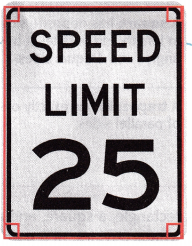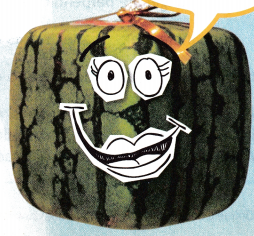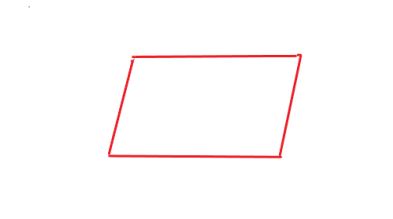All the solutions provided in McGraw Hill My Math Grade 4 Answer Key PDF Chapter 14 Lesson 9 Quadrilaterals will give you a clear idea of the concepts.
McGraw-Hill My Math Grade 4 Answer Key Chapter 14 Lesson 9 Quadrilaterals
All quadrilaterals have 4 sides and 4 angles. There are many different kinds of quadrilaterals.
Math in My World
Example 1
The speed limit sign represents a quadrilateral. Classify the angles formed by the quadrilateral. Determine if any of the sides are parallel or perpendicular.

1. Classify the angles.
There are _____________ right angles, __________ acute angles, and _____________ obtuse angles.
2. Determine if there are any parallel or perpendicular sides.

Since there are 4 right angles, the sides that form each right angle are perpendicular.
So, there are _______________ pairs of perpendicular sides.
Notice that opposite sides are also equal in length.

A quadrilateral with 4 right angles, opposite sides equal in length, and opposite sides parallel is a rectangle. A rectangle is a special kind of quadrilateral.
Answer: There are 4 right angles, 0 acute angles, and 0 obtuse angles.
The top and bottom sides are parallel
The left and right sides are parallel
So, there are 2 pairs of perpendicular sides.
Example 2
Classify the quadrilateral in as many ways as possible.

The quadrilateral has opposite sides equal in length and opposite sides parallel. It also has _______________ equal sides.
So, it is a _______________ and a _______________.
Answer: The quadrilateral has opposite sides equal in length and opposite sides parallel. It also has 4 equal sides.
So, it is a parallelogram and a rhombus.
Talk Math
Explain why a square is also a parallelogram.

Answer:
A parallelogram is a type of quadrilateral, where the opposite side are equal in length and are parallel to each other. A square also called as a parallelogram because its opposite sides are equal and parallel.
Guided Practice
Question 1.
Classify the quadrilateral in as many ways as possible.

It is a _____________, a _____________, a ______________, and a ______________.
Answer: It is a square, a rhombus, a parallelogram and a rectangle.
In a square, all the sides are equal in length, opposite sides are parallel to each other, and there are 4 right angles. Sometimes, the rotated version square with certain angle is termed as a rhombus. A square is termed as a rectangle, where all the sides of a rectangle are of equal length. When all the sides of a square a equal and parallel to each other, in some cases it can be treated as a parallelogram.
McGraw Hill My Math Grade 4 Chapter 14 Lesson 9 My Homework Answer Key
Practice
Classify each quadrilateral in as many ways as possible.
Question 1.

Answer: Trapezoid
Trapezoid is a type of quadrilateral, where it has one pair of parallel lines (i.e., opposite lines are parallel to each other).
Question 2.

Answer: Square
Square is a type of quadrilateral, where there are four right angles, all the sides are equal in size and opposite sides are parallel to each other.
Draw and classify a quadrilateral that fits each description.
Question 3.
4 right angles, oppo5ite sides equal in length and parallel
Answer: Rectangle

A rectangle is a type of quadrilateral, where there are 4 right angles, opposite sides are equal in length and parallel to each other. Observe the above figure for the given properties.
Question 4.
opposite sides equal in length and parallel
Answer: Parallelogram

A parallelogram is a quadrilateral with two pairs of opposite sides that are equal length and parallel. Observe the above figure for the given properties.
Problem Solving
Question 5.
Mathematical PRACTICE Be Precise Simon draws a rectangle with two sides that are 2 inches long and two sides that are 3 inches long. Chaz draws a figure with the same measurements, but it is not a rectangle. What figure could it be?
Answer: Parallelogram
Chaz draws a figure with the same measurements as of Simon, where two sides are of 2 inches long and other two sides are of 3 inches long. So, the figure could be parallelogram other than rectangle. As, A parallelogram is a quadrilateral with two pairs of opposite sides that are equal length and parallel.
Vocabulary Check
Question 6.
Explain the difference between a parallelogram and a rhombus.
Answer: Both Parallelogram and Rhombus are types of quadrilateral.
In a rhombus, all the four sides are equal in length, opposite sides are parallel to each other and the diagonals intersect at 90 degrees, whereas in a parallelogram, the opposite sides are equal in length, parallel to each other and the diagonals bisect each other.
Question 7.
Explain the difference between a square and a rectangle.
Answer: Both square and rectangle are types of quadrilateral.
In a square, all the sides are equal in length, opposite sides are parallel to each other, and there are 4 right angles.
In a rectangle, opposite sides are equal in length, opposite sides are parallel to each other, and there are 4 right angles.
The major difference between a square and a rectangle is that a square has all its sides equal, whereas a rectangle has its opposite sides equal.
Question 8.
How is a trapezoid different from the other four types of quadrilaterals you have learned about?
Answer: Trapezoid is a type of quadrilateral, where it has one pair of parallel lines (i.e., opposite lines are parallel to each other). It does not have opposite sides equal in length, as that of other quadrilaterals like square, rectangle, parallelogram and rhombus.
Test Practice
Question 9.
Which quadrilateral does not have opposite sides equal in length?
(A) rhombus
(B) trapezoid
(C) parallelogram
(D) square
Answer: B (Trapezoid)
Trapezoid is a type of quadrilateral, where it has one pair of parallel lines (i.e., opposite lines are parallel to each other). It does not have opposite sides equal in length.